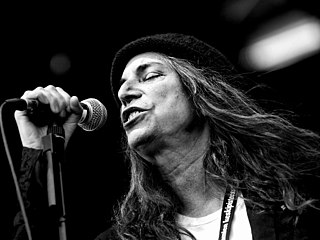
Patricia Lee Smith is an American singer-songwriter, poet, and visual artist who became an influential component of the New York City punk rock movement with her 1975 debut album Horses.

A threshing machine or thresher is a piece of farm equipment that threshes grain, that is, it removes the seeds from the stalks and husks. It does so by beating the plant to make the seeds fall out.

A carriage is a wheeled vehicle for people, usually horse-drawn; litters (palanquins) and sedan chairs are excluded, since they are wheelless vehicles. The carriage is especially designed for private passenger use, though some are also used to transport goods. A public passenger vehicle would not usually be called a carriage – terms for such include stagecoach, charabanc and omnibus. It may be light, smart and fast or heavy, large and comfortable or luxurious. Carriages normally have suspension using leaf springs, elliptical springs or leather strapping. Working vehicles such as the (four-wheeled) wagon and (two-wheeled) cart share important parts of the history of the carriage, as does too the fast (two-wheeled) chariot.
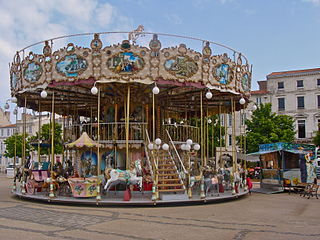
A carousel, roundabout, or merry-go-round, is a type of amusement ride consisting of a rotating circular platform with seats for riders. The "seats" are traditionally in the form of rows of wooden horses or other animals mounted on posts, many of which are moved up and down by gears to simulate galloping, to the accompaniment of looped circus music. This leads to one of the alternative American names, the galloper. Other popular names are jumper, horseabout, and flying horses.

The Hippodrome of Constantinople was a circus that was the sporting and social centre of Constantinople, capital of the Byzantine Empire. Today it is a square named Sultanahmet Meydanı in the Turkish city of Istanbul, with a few fragments of the original structure surviving.

The Powerhouse Museum is the major branch of the Museum of Applied Arts & Sciences in Sydney, the other being the historic Sydney Observatory. Although often described as a science museum, the Powerhouse has a diverse collection encompassing all sorts of technology including decorative arts, science, communication, transport, costume, furniture, media, computer technology, space technology and steam engines.

A draisine is a light auxiliary rail vehicle, driven by service personnel, equipped to transport crew and material necessary for the maintenance of railway infrastructure.

Hook Norton Brewery is a regional brewery in Hook Norton, Oxfordshire, England, several miles outside of the Cotswold Hills. Founded in 1849, the brewing plant is a traditional Victorian 'tower' brewery in which all the stages of the brewing process flow logically from floor to floor; mashing at the top, boiling in the middle, fermentation and racking at the bottom. Until 2006, the brewing process was powered by steam. Beer is still delivered in the village by horse-drawn dray.
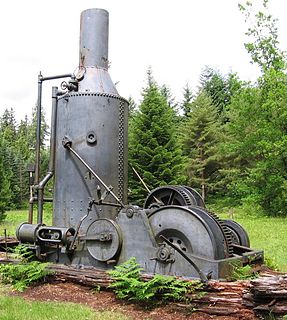
Steam donkey, or donkey engine, is the common nickname for a steam-powered winch, or logging engine, widely used in past logging operations, though not limited to logging. They were also found in the mining, maritime, and nearly any other industry that needed a powered winch.

The dandy horse, actually a derogatory term for what at the time was first called a Laufmaschine, then a vélocipède or draisienne, and then a pedestrian curricle or hobby-horse, is a human-powered vehicle that, being the first means of transport to make use of the two-wheeler principle, is regarded as the forerunner of the bicycle. Powered by the rider's feet on the ground instead of the pedals of later bicycles, the dandy horse was invented by Karl Drais in 1817 and then patented by him in France in February 1818 using the term vélocipède created by or for him. It is also known as a Draisine, and as a draisienne (French: [drɛzjɛn] in French and English. In English, it is also sometimes still known as a velocipede, but that term now also has a broader meaning.
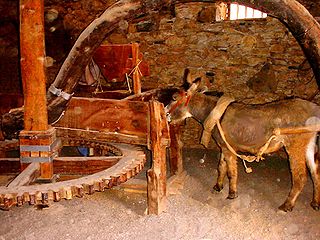
A horse mill is a mill, sometimes used in conjunction with a watermill or windmill, that uses a horse engine as the power source. Any milling process can be powered in this way, but the most frequent use of animal power in horse mills was for grinding grain and pumping water. Other animal engines for powering mills are powered by dogs, donkeys, oxen or camels. Treadwheels are engines powered by humans.

A steam tractor is a vehicle powered by a steam engine which is used for pulling.

An ox, also known as a bullock in Australia and India, is a bovine trained as a draft animal or riding animal. Oxen are commonly castrated adult male cattle; castration makes the animals more docile. Cows or bulls may also be used in some areas.

A portable engine is an engine, either a steam engine or an internal combustion engine, that sits in one place while operating, but is portable and thus can be easily moved from one work site to another. Mounted on wheels or skids, it is either towed to the work site or moves there via self-propulsion.

Bradford Industrial Museum, established 1974 in Moorside Mills, Eccleshill, Bradford, United Kingdom, specializes in relics of local industry, especially printing and textile machinery, kept in working condition for regular demonstrations to the public. There is a Horse Emporium in the old canteen block plus a shop in the mill, and entry is free of charge.
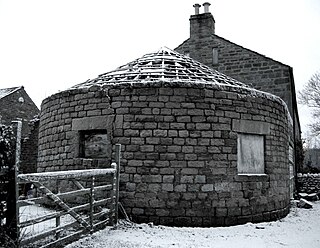
A gin gang, wheelhouse, roundhouse or horse-engine house, is a structure built to enclose a horse engine, usually circular but sometimes square or octagonal, attached to a threshing barn. Most were built in England in the late 18th and early 19th centuries. The threshing barn held a small threshing machine which was connected to the gin gang via wooden gears, drive shafts and drive belt, and was powered by a horse which walked round and round inside the gin gang.
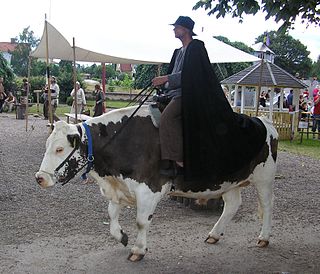
The following outline is provided as an overview of and topical guide to animal-powered transport:

The Irish Agricultural Museum is a museum dedicated to the history of Irish rural life. Housed in the farm buildings of Johnstown Castle, County Wexford, the collections represent all elements of rural life, including transport, crafts, farming activities and dwelling.

Horse coins are a type of Chinese numismatic charm that originated in the Song dynasty presumably as gambling tokens although many literary figures wrote about these coins their usage has always been failed to be mentioned by them, most horse coins tend to be round coins 3 centimeters in diameter with a circular or square hole in the middle of the coin. The horses featured on horse coins are depicted in various positions such as lying on the ground sleep, turning their head while neighing, or galloping forward with their tails rising high. it is currently unknown how horse coins were actually used though it is speculated that Chinese horse coins were actually used as game board pieces or gambling counters. Horse coins are most often manufactured from copper or bronze, but in a few documented cases they may also be made from animal horns or ivory. The horse coins produced during the Song dynasty are considered to be those of the best quality and craftsmanship and tend be made from better metal than the horse coins produced after. Some horse coins would feature the name of the famous horses they depicted. It is estimated that there are over three hundred variants of the horse coin. Some horse coins contained only an image of a horse while others also included an image of the rider and others had inscriptions which identify the horse or rider. During the beginning of the year of the horse in 2002 Chinese researchers Jian Ning and Wang Liyan of the National Museum of Chinese History wrote articles on horse coins the "China Cultural Relics Newspaper", the researchers noted that they found it a pity that the holes in the coins covered the saddles of the horses as this could've revealed more about ancient horse culture. Horse coins from the Song dynasty are the horse coins that are produced at the highest quality while horse coins from subsequent dynasties tend to be inferior compared to them.



















